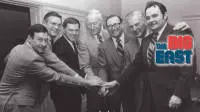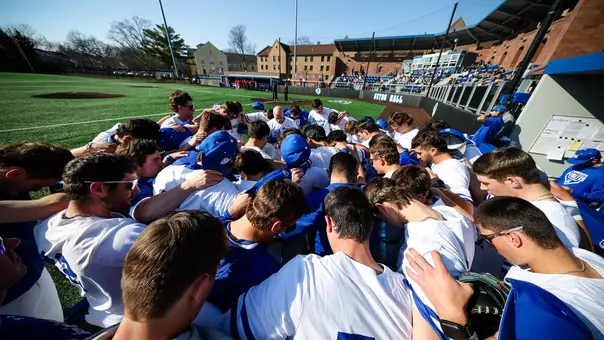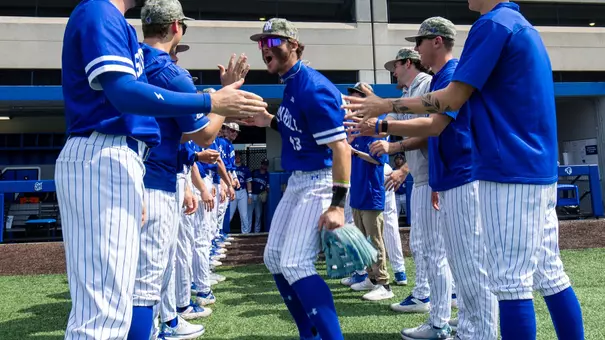
1979: Seton Hall Joins the BIG EAST
6/24/2013 12:00:00 AM | Baseball
Monday, July 1 officially marks the beginning of a new chapter in the storied history of the BIG EAST Conference. Through a series of features that will appear each day this week, SHUPirates.com will provide a snapshot of Seton Hall and its place as a founding member of the league, marking the Pirates' accomplishments over the first three-plus decades and outlining the vision for the future.
Today we begin with the story of the league's inception and how forward thinking and swift action helped shape the identity of the university's athletics program.
Opportunity - an intangible concept that often bears concrete ramifications. The key to making the most of an opportunity is the ability to recognize when it presents itself and just over 34 years ago, the course of Seton Hall athletics was changed forever due in large part to the efforts of two of the most influential figures in the history of the Pirates, who had the foresight to seize the chance that laid before them.
Conference re-alignment is far from a new phenomenon. Though a number of high profile conferences such as the BIG Ten or Southeastern Conference (SEC) have roots that long predate America’s bicentennial, the landscape of collegiate athletics as we currently know it began to take shape in the late 1970s.
Though Seton Hall had already asserted itself as a force on the national stage in a variety of sports, the school’s conference affiliation remained in a state of flux for the better part of the 20th century. The first catholic institution to field a men’s basketball team, SHU operated as an independent until shortly after World War II. In November 1947, Seton Hall helped found the East Coast Athletic Conference (ECAC) along with Boston College, Colgate, New York University and Syracuse University. The first of many short-lived conference associations in a three-decade span, it was as a member of the ECAC that the Pirates captured the 1953 National Invitation Tournament (NIT) title, led by all-time Pirate great Richie Regan.
After a brief stint as a member of the Eastern Intercollegiate Athletic Association (EIAA), The Hall joined the Metropolitan Collegiate Conference in the 1960's, along with Fairleigh Dickinson, Hofstra, Manhattan and Wagner, and became affiliated with the ill-fated New Jersey-New York Basketball Seven in the mid-1970's, partnering with Columbia, Fordham, Manhattan, Princeton, St. John's and Rutgers.
Despite an abundance of prominent, thriving universities on the east coast, no entity yet existed to tie them all together. The first such endeavor came in 1975 with the arrival of Eastern Collegiate Basketball League (ECBL), an early incarnation of the league currently known as the Atlantic 10. The league, which later adopted the name Eastern Athletic Association and more popularly referred to as Eastern 8, originally featured Villanova, Duquesne, Penn State, West Virginia, George Washington, Massachusetts, Pittsburgh, and Rutgers but though it had succeeded in organizing some of the most competitive programs on the coast, a major hole still remained in the area.
In 1978, the Pacific-8 added Arizona and Arizona State, becoming the Pac-10 and taking another step towards realizing the vision of becoming the premier athletic conference on the west coast. Over by the Atlantic however, there was still much work to be done.
A little over a year later, Providence College Athletic Director and former Friars basketball coach Dave Gavitt helped cultivate the league that would fill that void. Inspired by the success of the west coast schools, Gavitt served as the architect of the BIG EAST before the creation of its moniker. In early May of 1979, he and athletic directors from Georgetown, St. John’s, and Syracuse met at New York’s LaGuardia Airport and agreed to form a multi-sport conference. In order to ensure the long term viability of the new league, additional members with similarly sterling reputations were needed.
Among the first people that Gavitt turned to was his good friend Richie Regan. Regan had assumed the position of Athletic Director at his alma mater, continuing to capably guide the Pirates as he had during his days on the court. Due in large part to Regan’s influence, Seton Hall was extended an invitation to be a member of the conference from its inception, but that prospect was threatened due to complications with the entry fee.
Convinced that the new league would elevate Seton Hall to new heights, Regan enlisted the aid of Seton Hall Athletics Hall of Famer Bill Eyres, a devoted alum and generous benefactor of the university and athletics. Eyres personally gifted the five-figure sum, opening the door for a new era in Seton Hall history.
“I felt it was really worthwhile to do it,” Eyres recalled in a recent phone interview. “If we didn’t do it then we wouldn’t have been in and somebody else would have been.”
| SHU Athletics Hall of Famer Bill Eyres opened the door for Seton Hall to join the BIG EAST |
“Richie always used to say that without Bill Eyres, we wouldn’t be in the BIG EAST,” said baseball coach emeritus Mike Sheppard Sr., who was in the
beginning stages of his own legendary career at the time. “I remember Bill was very excited about the BIG EAST, felt that it was going to be special and somebody needed to hurry up and get something done. He would say ‘the train is leaving the station and either you’re going to be on it, or you’re going to miss it.’”
Thanks to Eyres’ gift, Seton Hall wasn’t left standing on the platform and on May 31, 1979, Richie Regan was on hand along with Gavitt and representatives from the other six original members – Boston College, Connecticut, Georgetown, Providence, St. John’s, and Syracuse – when the conference was formally initiated in a meeting in the Providence Civic Center boardroom. The directors agreed to conduct championships in men’s cross country, indoor track, outdoor track, golf, tennis, and swimming in the first year, in addition to a single round of in-season play and a post-season tournament in basketball.
What has ensued has been a 34-year ride that has seen the BIG EAST ascend to a level of national prominence that at the very least rivals any conference in America. Two primary factors in that rise were early partnerships with another startup organization, ESPN, as well as Madison Square Garden. As the BIG EAST embarks on its new phase, it has positioned itself to be a presence in households across the country, once again uniting with a burgeoning media outlet, Fox Sports. The league has also maintained its place in Madison Square Garden, holding true to Gavitt’s original vision of creating the best collegiate basketball conference.
“I remember the day that the BIG EAST formed,” said former league commissioner Mike Tanghese, shortly after Gavitt passed in 2011. “Dave said to everyone in the room, ‘We’re going to Madison Square Garden and it’s going to be the best basketball tournament in the country.’ No one in the room understood.”
In essence, the new version of the BIG EAST represents a return to many of the values that led to its creation. Through all the instability that has dominated media reports and mired the collegiate sports landscape, Seton Hall stands as one of four remaining founding members of the conference and is poised to help the league continue its remarkable tradition through this fresh start.
A new opportunity.




























